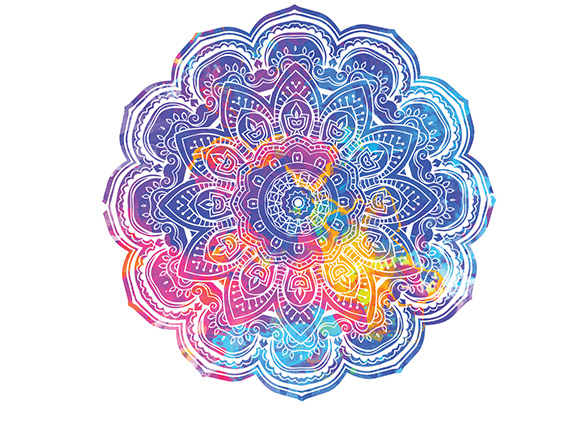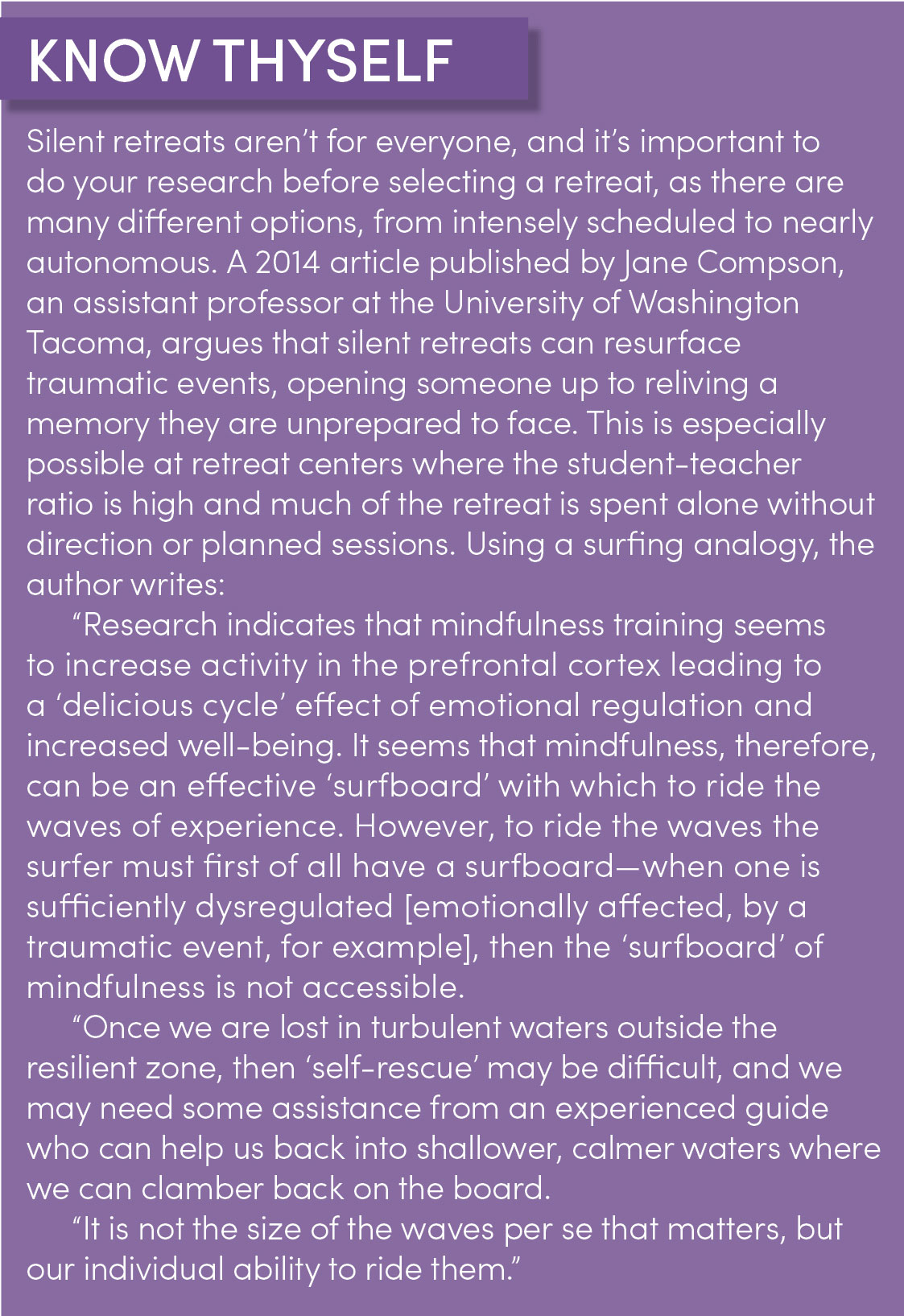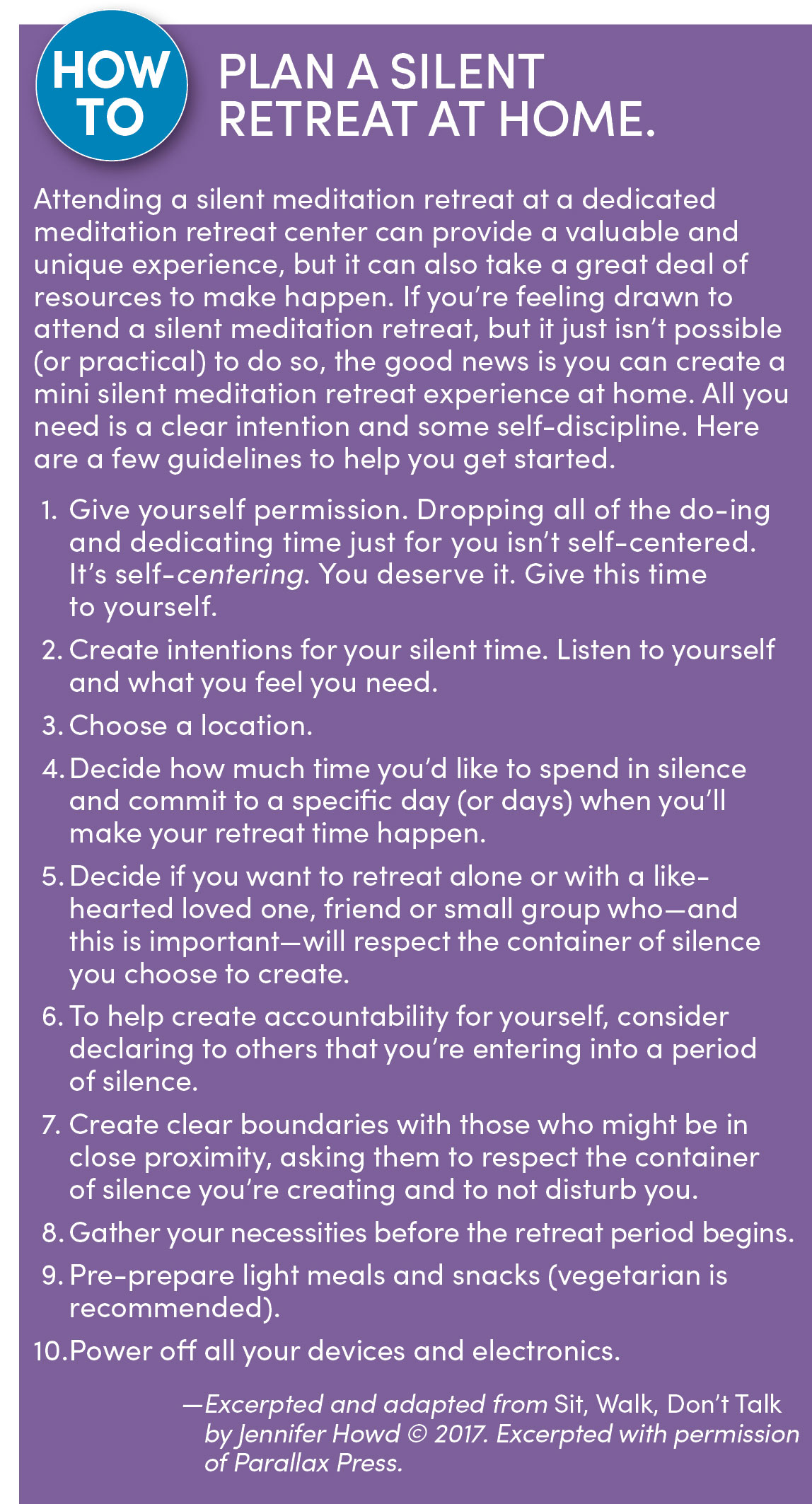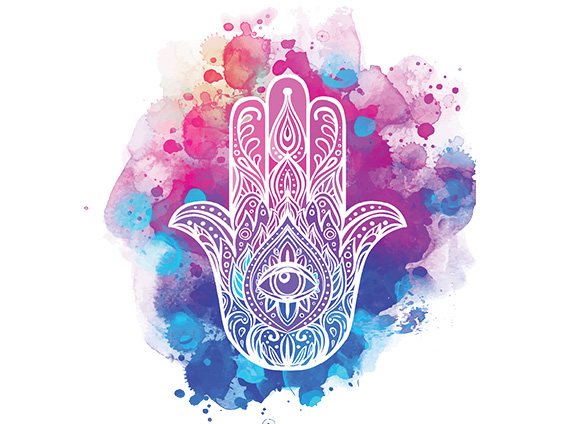My heart is racing. An imaginary band tightens around my chest. I want to scream, but my mouth can’t produce sound. I want to run, but my feet feel cemented in the dewy grass. It’s a relatively warm night, but my hands are cold and clammy.
This feels like a nightmare, except I’m not asleep. What began as a harmless trip down memory lane has mutated into a paralyzing visit to loathsome memories once protected by meticulously planned distractions. It’s the middle of the night. Time seems to have stopped, abandoning me to relive a thousand moments of painful regret that feel as real as the first time I lived them.
Logically I know these are just memories. Logically I know I’m safe. But my brain, firing in a million directions, is engulfed by uncontrollable thoughts and emotions.
Related: Use These Mental Techniques When Your Brain Is Overwhelmed
***
Tattooed on my right rib cage is the phrase “This too shall pass.” I’m not especially spiritual, but the words have always stuck with me. The impulse to ink them on my body came after a particularly difficult breakup. Whenever I catch a glimpse of the words in the mirror, I smile. It brings me strength somehow. It’s also a lie.
The biggest paradox in my life is that I’m the most laid-back version of a neurotic, overthinking, anxious control freak. I don’t let anything pass. That’s not to say I’m consumed by regurgitated memories of social mishaps, but I do my fair share of ruminating. So I stay busy. When I’m busy, I don’t think. Distraction disguised as going with the flow. Maybe that’s why I volunteered to attend a three-day silent retreat in a little town called Windom, Texas.
Past the 10 miles of winding roads leading away from the state highway. Past the three-stoplight town of Dodd City, Texas. Past the lazy herd of brown dairy cows chewing idly under the shade of a giant oak. Nestled up the hill from a stark white wooden sign that reads, “Siddhayatan—a Hindu-Jain Tirth & Spiritual Retreat” sits a cluster of matte brown buildings framed by trees with blooming pink and white flowers.
From the top of the hill, the view is breathtaking. Miles of rolling green hills dotted with livestock and trees as far as you can see in any direction. It’s been a while since the last time I couldn’t hear the sound of a car or see lights from the tops of skyscrapers. Since the last time I couldn’t smell exhaust fumes or greasy fast food. I roll down the windows to breathe in the thick, warm farmland air.
Although I’m not exactly sure what I’m in for, I’m exhilarated to have a few relaxation days in the middle of nowhere. It feels like a break to smell both the literal and proverbial roses. I’m going to learn how to stop valuing busyness. I’m going to learn not to feel guilty for moments of non-productivity. Maybe I’ll even try my hand at meditation.
Related: I Actually Tried Meditation for 30 Days—This Is What Happened
A small group of people dressed in various cuts of baggy white clothing, hands clasped together behind their backs, stands in a semi-circle around an old man with curly, shoulder-length, salt-and-pepper hair. The group turns with mild curiosity as my car passes.
Panic takes over. Was I supposed to wear white? No one told me that! I wonder if I missed something in the brochure. I look down at my tight black yoga pants and gray T-shirt printed with “Cinco De Mayo Volley Fiesta” feeling intensely out of place. An onslaught of hyperactive thoughts bombard me. Why did I volunteer to come here when our office discovered the place is just an afternoon’s drive away? Why do I always say yes before considering the consequences? What if I don’t learn anything from this?
The nervous questions in my head are interrupted by a soft rap on the driver’s side window. A young woman wearing white robes, with jet black hair swept into a bun, immediately bows apologetically. Startled, I accidentally—and regrettably—drop a casual F-bomb. Not the first impression I was hoping for.
I’ve always believed there to be a literal, physical limit to the number of social cues that one person can miss before one of two things happen: They catch on and adjust their behavior, or they just melt into the environment, blissfully unaware—a gift from the universe. My first 20 minutes at Siddhayatan becomes proof there’s a third option: You wish yourself to melt into the environment, but you stay, painfully, tragically present.
“Jai Siddhatma,” the woman says as I get out of the car, slightly bowing again with her palms pressed together in a praying motion. It’s their greeting here. It means, “Victorious are liberated souls!”
“Oh. Hi,” I respond, an unenlightened idiot. And then I drop my phone onto the gravel.
I don’t remember what transpires in the next few minutes, but quickly I’m walking behind her toward a large brown A-frame building. My polka dot rubber flip-flops look ridiculous next to the pairs of simple off-white sandals neatly lining the wooden porch, but at least I remember to take them off. Social cue noted. Things are looking up.
The building is simple, forgettable: A small kitchen on the left, three plastic cafeteria tables, two small white couches and an overstuffed armchair. A large cardboard cutout of a white dog’s face looks cartoonish next to tables of incense, prayer beads and meditation shawls for sale.
“You can sit here,” the woman says. Still staring at the dog, I move toward the couch.
“You can sit here,” she repeats a little louder. That’s when I notice her motioning to the floor. Any progress I’ve made with the shoe removal has vanished. This is not at all what I expected.
***
Attending a spiritual retreat is kind of like visiting another country. No matter how much you planned, researched and prepared, the culture shock is jolting to the system. Add in a vow of silence, and you feel nearly infantile, mimicking facial expressions, body language, sounds that make up words that hold no meaning to you. The more you try to fit in, the more ridiculous you appear.
I signed up for this partially out of curiosity (Can I really go without speaking for three days?) and partially because I’m a naturally competitive person who seeks adventure. Exploring a spiritual practice that I know nothing about, in the middle of nowhere, while daring myself to eliminate the thing I do most, seems to satisfy those parameters.
My thirst for adventure is quickly replaced with a palpable desire to go home and hang out with my cat, who doesn’t care if I’m wearing white or sitting on the couch. It’s uncomfortable sticking out, and over the next two and a half days, I learn two important things about myself: First, I am excruciatingly controlling when it comes to how I think my life should be. Second, somewhere deep inside me, I ache to replace that desire for control with raw, unbridled emotion and pure meaning.
Silent meditation retreats have a long, rich history in Buddhist teachings. Only in the past 30 to 40 years have these escapes from “normal” life gained popularity. The premise, simply put, is to learn how to be alone with yourself. To take out the expectations of speech and interaction, and instead dive deeply within yourself to find clarity, a renewed sense of purpose and awareness.
Related: How I Learned to Enjoy Being Alone
“If I had to summarize the entirety of most people’s lives in a few words, it would be endless resistance to what is,” writes Haemin Sunim, a Zen Buddhist teacher and author of The Things You Can See Only When You Slow Down. “As we resist, we are in constant motion trying to adjust, and yet we still remain unhappy about what is.”
As poetic as it sounds to surrender to “what is,” my experience was less peaceful. There can be real anxiety, even agony, when you spend time alone with whatever thoughts arise, when you’re victim to the whims of your own dark psyche.
***
I registered for a shared room but end up the sole occupant of Room 1. Like the main building, the room is simple. Just two twin beds, one nightstand, a rug, a lamp and a small shelf. My pink and orange overnight bag feels irreverent, like wearing neon pink to a funeral.
The shared bathroom is small but pristine. A laminated sign hangs next to the mirror, informing us that we’re staying in an ashram, a place of spiritual learning and nonviolent living. No living things (including bacteria) are to be harmed, the sign reads. Perhaps for the first time, I’m acutely aware of ants underfoot, whose precious lives could be extinguished with a single clumsy step.
The chatter spilling from the main building makes me pause. About 10 people are sitting on meditation pillows while a few others exchange small talk at a table. The woman I met earlier motions me toward a pillow and hands me a sheet filled with words I don’t know how to pronounce.
“Cecilia is our newest guest,” she announces to the room. “She’s taken a vow of noble silence, so don’t be offended if she doesn’t respond.”
“Jai Siddhatma,” the smiling group says.
I smile in response and wonder: Am I the only one in silence? A new wave of panicked thoughts swirls through my brain. I don’t like silence. I’m the one who fills awkward silence with humor, usually of the self-deprecating or sarcastic variety. But before I have time to host another internal freak-out party, the mantra chanting session begins.
Before I have time to host another internal freak-out party, the mantra chanting session begins.
“Aum, Aum, Aum,” the group begins to chant in a low, deep, rhythmic tone. I don’t know what I’m supposed to do. Does mantra chanting count as speaking? Is it disrespectful if I don’t chant? “Jaga-Naaho Jaga-Bhamdhu, Jaya-E Jagappiyaa-maho,” they continue. The rhythm is soothing. When chanted correctly, mantras can “heal, protect, calm down your mind and body, increase intellect, help overcome challenges, bring prosperity, reduce stress and increase your focus,” according to the retreat brochure. At Siddhayatan, they chant mantras twice a day, before breakfast and dinner.
The session lasts just long enough for my right leg to fall asleep and my lower back to start aching. Pain and hunger send a new wave of whiny thoughts. I shouldn’t have to sit here if I don’t want to. Why is there a kid here? He won’t sit still, and it’s distracting. They should have served a snack before this. Why is that woman smiling? Who does she think she is? I dream of pizza and my memory foam mattress while complaints consume my every thought.
Jennifer Howd, author of Sit, Walk, Don’t Talk: How I Survived a Silent Meditation Retreat, says this kind of inner monologue is natural, especially for first-timers.
“Meditation retreats are like a spiritual boot camp,” she tells me when we catch up after the retreat. “Your internal stuff you’ve not been facing is going to get kicked up. The people around you are going to kick it up.”
At dinner, I am one of 14 and the only person who’s taken a vow of silence. It’s brutal. The guests are polite, offering yes or no questions to keep me in the conversation, but honestly I’d rather they just ignore me. Still, listening to their chatter allows me to exit my own headspace, which is a welcome reprieve. The women at my table have been here for a while. They gossip like old friends at a dinner party. Lily, a competitive tennis player from El Paso, Texas, just turned 30 and is looking for a fresh perspective on life. She starts a water fast tomorrow.
“I heard one guy lasted 12 days on a water fast,” says Caroline from San Francisco. She’s volunteering at the retreat for a month. I’m grateful to see she’s wearing yoga pants, too. A middle-aged woman named Cheryl is here with her mother, Laura, from Albuquerque. They attend retreats every year as a mother-daughter bonding experience.
The conversation leaves me hopeful. I might feel like a stranger, but these women are normal people with normal jobs in normal places. I reach for another piece of naan, uplifted by my newfound friends.
It doesn’t take long, though, before I start to worry about the upcoming full solitary night of quiet.
***
It’s 2:30 a.m. and the silence is deafening, excruciating. I thought I knew how to be alone, how to do nothing at all, but this is a new beast. Who knew how intensely you could feel every single lingering moment? I walk outside. The once beautiful silence of the open fields is now eerie. I long for a police siren, a barking dog, the murmurs of a drunk neighbor, anything.
“There isn’t nearly enough nothing in the world,” Christopher Knight, the infamous North Pond Hermit who lived in the woods of northern Maine for 27 years, once said. To the uninitiated, nothing is immense, overpowering, consuming. In the real world, the one I left behind, I can feign a sense of control. In the real world, I’m only a smiling Instagram or new planner away from having it all together. I longed for this. To feel something more than the shallow waters of the mundane. Yet I fight it, straining against the uncomfortable realities of solitude.
I wonder what’s happening at home. Someone might miss me, but the world hasn’t stopped spinning. My office will come to life in a few hours. If I never came back, they’d manage. The thought makes me feel small but also free. The day-to-day stresses that normally leave me reeling now seem inconsequential. I’m not sure if this is a form of mindfulness, but for a brief moment, as I lie here on the cool grass, I feel weightless.
Related: How to Make Mindfulness Part of Your Daily Routine
“The funny thing about stopping is that as soon as you do it, here you are. Things get simpler,” writes Jon Kabat-Zinn, founder of the Stress Reduction Clinic and the Center for Mindfulness in Medicine, Health Care, and Society. “In some ways, it’s as if you died and the world continued on. If you did die, all your responsibilities and obligations would immediately evaporate.” It’s terrifying and beautiful at the same time.
The serene moment doesn’t last. Before long, I revert to what mindfulness experts call monkey brain. Like a monkey swinging through a forest, I jump from thought to thought as if I’d never developed the ability to focus.
“We tend to be particularly unaware that we are thinking virtually all the time,” Kabat-Zinn writes. “The incessant stream of thoughts flowing through our minds leaves us very little respite for inner quiet.”
Sleep evades me the rest of the night. It’s as if my brain wants me to remember every embarrassing, regretful moment in my past. Missed birthdays, white lies, not-white lies, missed opportunities, failed relationships, dead pets, awful co-workers, awful bosses. I switch between guilt and anger until my face is hot. The more I try to block the flow of thoughts, the faster and more ferociously they flow.
“There is a misconception about mindfulness meditation,” Howd says. “It’s not about trying to stop thinking. The job of the mind is to think. Instead we’re developing new relationships with our thoughts.”
One technique is to imagine your emotions as waves of an ocean. You can see the waves going past you. You can feel the cold water. A wave pushes against you, but it’s not powerful enough to displace your feet. The goal is to separate yourself from the emotion and watch it come and go.
But it doesn’t happen overnight. Like any form of growth, Howd warns, mindfulness requires consistency.
“For years, I poked in and out of the practice,” she says. “When things fell apart or got difficult, I was here and I would practice. Then as soon as life got better, I would stop.”
At some point—I can’t say for sure when—my thoughts slow down. Or wear me out. Or I ride them until the memories scrolling through my head turn into dreams I won’t remember.
***
After the first night, things get easier. I wake up feeling silly and just a little crazy.
My mind had entered fight-or-flight mode, says Jane Compson, an assistant professor at the University of Washington Tacoma. “Acute or even mild stress can put the regulating functions of the prefrontal cortex relatively ‘offline,’ ” she writes in a 2014 article. “The implication here is that ‘just sitting with it’ is an incomplete instruction—students need to be taught how to cope with some of the mental and physical phenomena that may arise from this experience.”
Facing the thoughts in my head was more difficult than I expected, and I start to crave the distractions the way an addict craves a fix. I might yearn for deeper waters, but the safety of routine distractions beckons me like an old friend.
Related: 4 Ways to Actively Reprogram Your Thoughts
After morning mantras, at breakfast, I’m more reserved than before, lost in the replay of the previous night. Lily sips on a mug of warm water and stares longingly at our bowls of plain oatmeal topped with bananas and cinnamon. She’s tall and thin but muscular, with long black curly hair. I imagine she’s not used to skipping meals. Her skin is smooth and bright, the face of someone who rarely, if ever, wears makeup. Not even a hint of age has touched the corners of her eyes.
“I think I’ll miss the chai tea the most,” she says. And she’s right. The food is simple: Lunch and dinner are composed of various combinations of vegetables, chickpeas, rice and tofu topped with a spicy orange sauce. It’s well seasoned and flavorful, but repetitive. The chai, made from scratch, is served steaming hot in white porcelain mugs. Its creamy, spicy blend seems to warm your bones.
“Jai Siddhatma, truth-seekers” says Acharya Shree Yogeesh, the curly haired monk, approaching our table with a bow. A quick internet search later informs me that he is kind of a big deal. He founded Siddahayatan along with another retreat in Los Angeles, New Delhi and a school in India. He’s the author of several spiritual training books, a sought-after speaker and recipient of the highest honor given by Jains for his spiritual work around the world.
Life isn’t about avoiding suffering. It’s not just killing time during the negative parts.
We, the guests, are truth-seekers. The only scheduled events at Siddyahatan are mantras and meals. Of course, various classes or one-one-one sessions are available with the teachers for an additional fee. But the overall goal of this ashram is intended to be a safe environment for truth seekers to set aside their ego in search of a more authentic relationship with themselves and others.
“A truth seeker is one that becomes silent, not from words, but from anger, violence, emotions, pain, suffering, ignorance and all the lower qualities,” Yogeesh writes in Secrets of Enlightenment. I thought abstaining from words was hard enough.
I spend the majority of the second and third days wandering the grounds or reading. Behind the main building sits a small vegetable garden filled with plump tomatoes, shiny peppers and bulbous zucchini. My mom used to keep a garden. She once told me that when a white patch appears on a zucchini, it’s time to harvest. It happens quickly so you have to check them every day. At Siddhayatan, waste is considered a form of violence. They’ll wait until they know they can eat this zucchini before pulling it from the vine. Any leftovers will be saved and reheated until every morsel is eaten.
At lunch and dinner, when the newly ordained monk serves me (it’s common practice for the monks and nuns to serve the guests), I’m conscious of my portion sizes, refusing a second helping. I’m still hungry, but I’m not sure if I can eat another plate. Back home, I would have eaten until I was stuffed and then thrown away whatever was left.
This life is simple yet disciplined. Rarely do I consider the ripple effects of my daily routine. For them, it’s the highest priority.
“As human beings, we’re actually capable of greatness of spirit,” writes Sharon Salzberg in Real Love: The Art of Mindful Connection, “with an ability to go beyond the circumstances we find ourselves in, to experience a vast sense of connection to all of life.”
***
On the third day, without a word to the monks or other guests, I pack my bags quietly and drive away. The vow is over. I thought I’d want to make a phone call as soon as I got to my car, just a friendly chat on the long drive home. But I didn’t. Instead, my grumbling stomach persuades me to stop for a snack in Dodd City. The building, which houses both a doughnut shop and a dry cleaner, looks like the basement of an old church. Sitting at a long cafeteria table in the middle of the room are 10 people enjoying a community breakfast. They turn to greet the stranger at the door with wide smiles and even a few waves. Normal people in a normal place. Their friendly natures are a cue to swallow the hangry thoughts bubbling under the surface.
I’m exhausted, but I don’t feel transformed by the retreat, which Howd says is to be expected.
“You can’t go away for a couple of days or a week, come back, not have a [meditation] practice and expect that your life is going to completely change,” Howd says. “That’s not realistic.”
But it did help remind me that life isn’t about avoiding suffering. It’s not just killing time during the negative parts. It’s about learning techniques to feel comfortable with just being with those very natural times in our lives.
“Meditation is the only intentional, systematic human activity, which at the bottom is about not trying to improve yourself or get anywhere else, but simply to realize where you already are.” Kabat-Zinn writes.
So yes, this moment of hangriness, judgment uncertainty, embarrassment, fear, pain or anger will pass. But until then, I’m going to let it be.
Related: 6 Steps to Discover Your True Self
This article originally appeared in the December 2017 issue of SUCCESS magazine.





